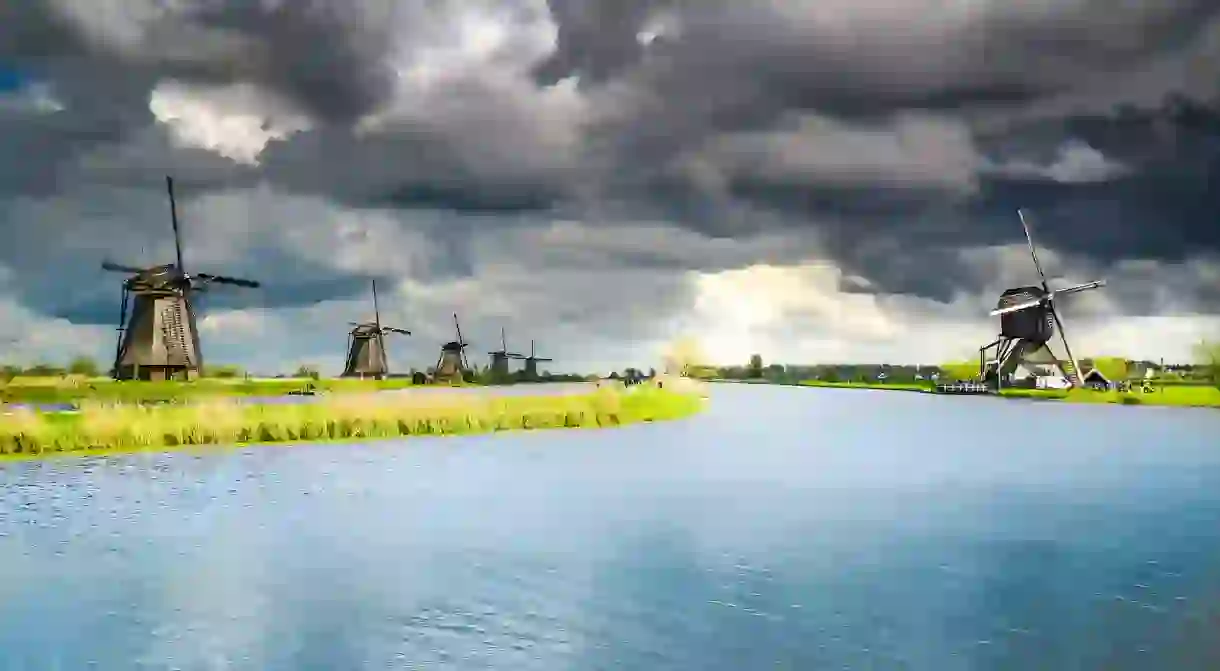A Guide to Visiting the Windmills in Kinderdijk

A living testament to the Netherlands’ age-old struggles with rising waters, the mill network at Kinderdijk was built to keep the surrounding region safe from floods. It became a UNESCO World Heritage Site in 1997 due to its cultural, historical and technological significance.
The low-lying, waterlogged village of Kinderdijk
Located roughly 15km east of Rotterdam, Kinderdijk stands on a waterlogged stretch of land surrounded by two rivers. Due to its proximity to these bodies of water and its low-lying topography, this region has always been threatened by floods. To keep the water at bay, local residents built a series of earthworks in the 13th century that channelled water away from their homes and farms. Though these dykes, sluices and canals protected the region for generations, by the 18th century, the whole system needed updating.

To improve the region’s water-management facilities, a series of windmills were constructed near Kinderdijk around 1740. Like many other windmills in the Netherlands, these mammoth machines were specifically designed to drain wetlands and were fitted with mechanical wheels or hydraulic screws that could move water quickly and efficiently. By harnessing the wind, the mills transferred water from lower parts of Kinderdijk into a higher basin that flowed into a nearby river, creating an expansive irrigation system.

In the mid-19th century, two steam-powered pumping stations were added to the network, to give the windmills a helping hand. Less than a century later in 1924, the installation was modernised once again, when pumps hooked up to diesel engines were built to replace the early stations, boosting Kinderdijk’s capabilities significantly. Even though Kinderdijk switched to electricity in the late 20th century, its windmills are still kept in working order – this is to ensure that the installation remains operational in case of emergency situations, such as massive power outages.
What to see in Kinderdijk
Nowadays the entire windmill system and its surroundings are protected as a UNESCO World Heritage Site. Though it is easy enough to spend an entire day wandering through the network, marvelling at its windmills, there are also two museums to visit, if you are eager to learn more about the region’s history.
These museums are housed inside windmills and dedicated to the history of milling. The first, known as Nederwaard Museum Mill, retraces the lives of its former occupants, the Hoek family, who lived and worked inside the mill for generations. The second, Blokweer Museum Mill, is inside the oldest mill in Kinderdijk, which was completed around a century earlier than its neighbours in 1631.

How to get to Kinderdijk
Due to its proximity to Rotterdam, travelling to Kinderdijk is an absolute breeze. Aside from regular bus services from Rotterdam’s Zuidplein station, visitors can also travel to Kinderdijk from the city via a waterbus which embarks from a terminal near Erasmus Bridge. After jumping aboard a boat, travellers must change at Riderkerk terminal, then catch another waterbus that sails directly to Kinderdijk. The whole journey takes around 35 minutes and allows visitors to discover the region’s waterways before exploring Kinderdijk.

It is also worth mentioning that cyclists are welcome at Kinderdijk and it is possible to explore the network by bike thanks to the area’s many cycle paths. It only costs €8 for adults and €4 for kids aged four to 12 to enter Kinderdijk (and younger kids can visit free of charge).

Visit the windmills at Kinderdijk
Museum

Quite possibly the Netherlands’ most famous UNESCO World Heritage Site, the Windmill Network at Kinderdijk were first constructed in the mid-18th century. This collection of 19 historic windmills was constructed to prevent flooding and drain the surrounding area of water. Spread over several kilometres of low-lying, waterlogged land, the windmills form a stunning landscape that looks as though it hasn’t changed for centuries. Visitors are free to explore the network by foot or bike and may learn more about Kinderdijk’s history at two museums housed inside still-functional windmills.













